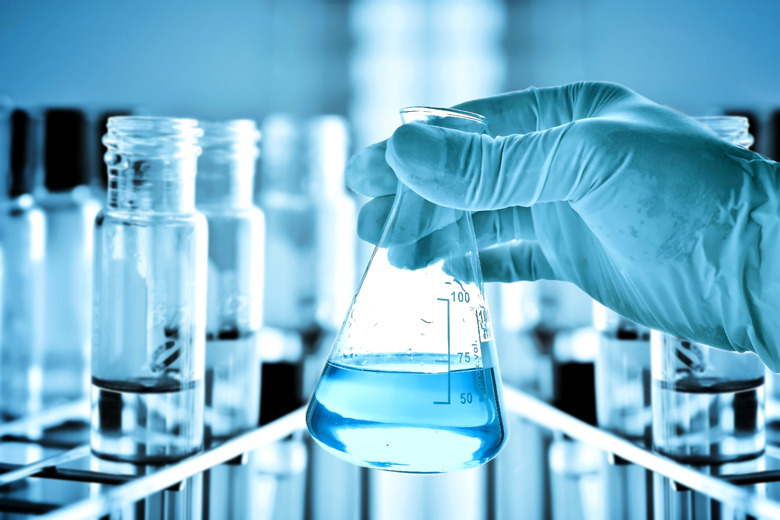What Are Dependent, Independent & Controlled Variables?
Say you're in lab, and your teacher asks you to design an experiment. The experiment must test how plants grow in response to different colored light. How would you begin? What are you changing? What are you keeping the same? What are you measuring?
These parameters of what you would change and what you would keep the same are called variables. Take a look at how all of these parameters in an experiment are defined, as independent, dependent and controlled variables.
What Is a Variable?
What Is a Variable?
A variable is any quantity that you are able to measure in some way. This could be temperature, height, age, etc. Basically, a variable is anything that contributes to the outcome or result of your experiment in any way.
In an experiment there are multiple kinds of variables: independent, dependent and controlled variables.
What Is an Independent Variable?
What Is an Independent Variable?
An independent variable is the variable the experimenter controls. Basically, it is the component you choose to change in an experiment. This variable is not dependent on any other variables.
For example, in the plant growth experiment, the independent variable is the light color. The light color is not affected by anything. You will choose different light colors like green, red, yellow, etc. You are not measuring the light.
What Is a Dependent Variable?
What Is a Dependent Variable?
A dependent variable is the measurement that changes in response to what you changed in the experiment. This variable is dependent on other variables; hence the name! For example, in the plant growth experiment, the dependent variable would be plant growth.
You could measure this by measuring how much the plant grows every two days. You could also measure it by measuring the rate of photosynthesis. Either of these measurements are dependent upon the kind of light you give the plant.
What Are Controlled Variables?
What Are Controlled Variables?
A control variable in science is any other parameter affecting your experiment that you try to keep the same across all conditions.
For example, one control variable in the plant growth experiment could be temperature. You would not want to have one plant growing in green light with a temperature of 20°C while another plant grows in red light with a temperature of 27°C.
You want to measure only the effect of light, not temperature. For this reason you would want to keep the temperature the same across all of your plants. In other words, you would want to control the temperature.
Another example is the amount of water you give the plant. If one plant receives twice the amount of water as another plant, there would be no way for you to know that the reason those plants grew the way they did is due only to the light color their received.
The observed effect could also be due in part to the amount of water they got. A control variable in science experiments is what allows you to compare other things that may be contributing to a result because you have kept other important things the same across all of your subjects.
Graphing Your Experiment
Graphing Your Experiment
When graphing the results of your experiment, it is important to remember which variable goes on which axis.
The independent variable is graphed on the x-axis. The dependent variable, which changes in response to the independent variable, is graphed on the y-axis. Controlled variables are usually not graphed because they should not change. They could, however, be graphed as a verification that other conditions are not changing.
For example, after graphing the growth as compared to light, you could also look at how the temperature varied across different conditions. If you notice that it did vary quite a bit, you may need to go back and look at your experimental setup: How could you improve the experiment so that all plants are exposed to as similar an environment as possible (aside from the light color)?
How to Remember Which is Which
How to Remember Which is Which
In order to try and remember which is the dependent variable and which is the independent variable, try putting them into a sentence which uses "causes a change in."
Here's an example. Saying, "light color causes a change in plant growth," is possible. This shows us that the independent variable affects the dependent variable. The inverse, however, is not true. "Plant growth causes a change in light color," is not possible. This way you know which is the independent variable and which is the dependent variable!
Cite This Article
MLA
Gupta, Riti. "What Are Dependent, Independent & Controlled Variables?" sciencing.com, https://www.sciencing.com/dependent-independent-controlled-variables-8360093/. 10 February 2020.
APA
Gupta, Riti. (2020, February 10). What Are Dependent, Independent & Controlled Variables?. sciencing.com. Retrieved from https://www.sciencing.com/dependent-independent-controlled-variables-8360093/
Chicago
Gupta, Riti. What Are Dependent, Independent & Controlled Variables? last modified March 24, 2022. https://www.sciencing.com/dependent-independent-controlled-variables-8360093/
